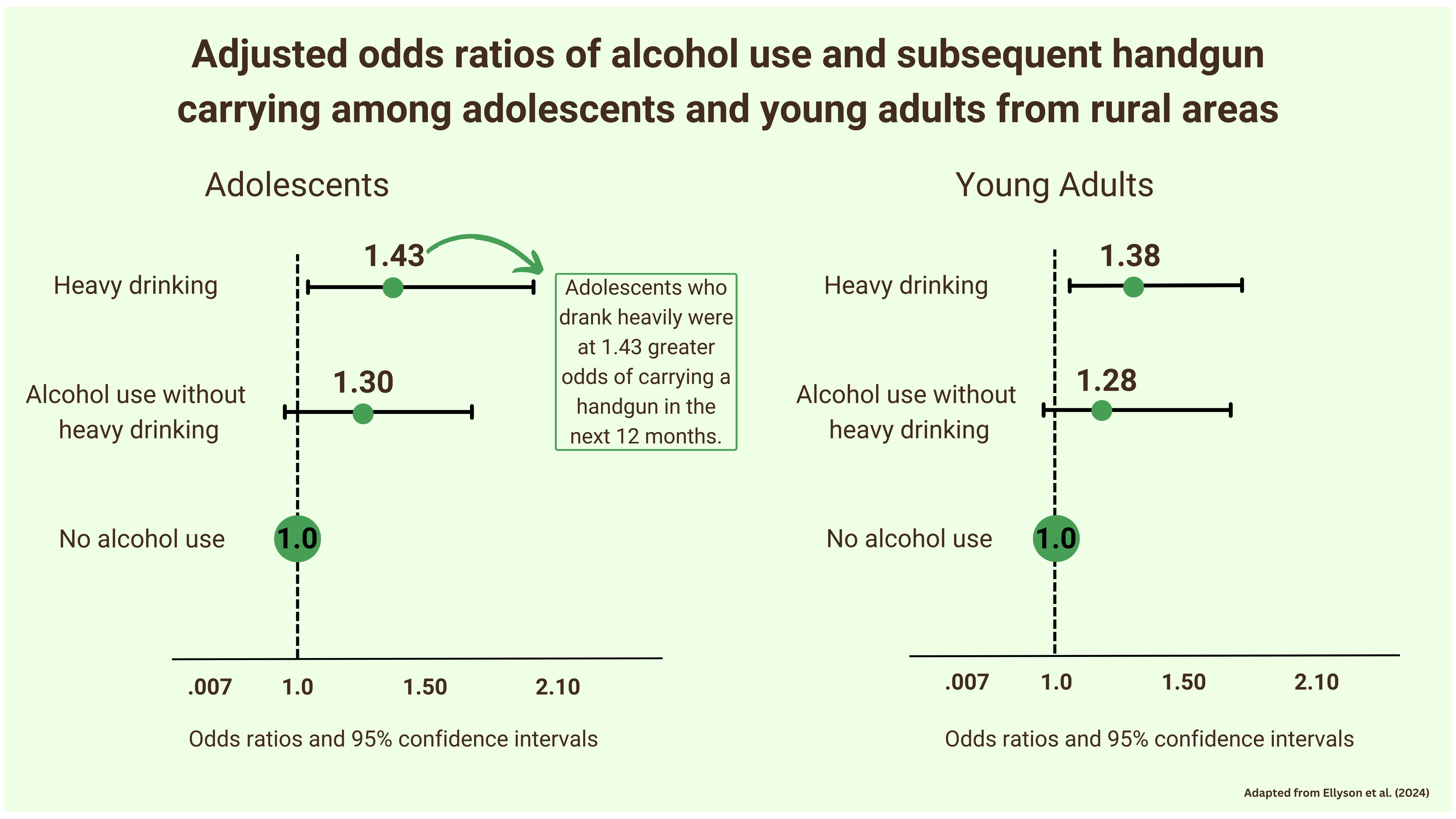Adolescents from rural areas are more likely to carry handguns and to drink alcohol than adolescents from urban areas. Handgun carrying is associated with firearm-related harm and other threatening acts, such as bullying and physical violence. Research also indicates that alcohol use may even be a precursor to handgun carrying, perhaps due to alcohol’s harmful impacts on adolescent brain functioning and impulse control – leading teens to perceive threats where there are none – and perhaps because behaviors like drinking, carrying guns, stealing, violence, and damaging property tend to cluster together in some groups of teens. However, it is unclear whether drinking precedes handgun carrying among rural teens and young adults. This week, The DRAM reviews a study by Alice M. Ellyson and colleagues that examined the longitudinal association between type of alcohol use and handgun carrying among adolescents and young adults from rural areas.
What was the research question?
Among adolescents and young adults from rural parts of the United States, does drinking increase the risk for later handgun carrying?
What did the researchers do?
The researchers extracted survey results from 2,002 participants from rural communities ages 12 to 26 collected from a longitudinal Community Youth Development Study (CYDS). CYDS personnel collected data from adolescents over ten waves between 2004 and 2019: each age 12 to 16, and then 18, 19, 21, 23, and 26. In each wave, they asked participants whether they carried a handgun in the past month and whether they engaged in heavy drinking1 or alcohol use without heavy drinking2. The researchers also examined individual and community level variables that could have potentially contributed to alcohol use and handgun carrying. In the main analysis, researchers analyzed these data using logistic regressions and conducted secondary sensitivity analyses to identify other influences on alcohol use and handgun carrying not explored in the main analysis.
What did they find?
The number of participants who reported any type of alcohol use grew from ages 12 to 26, peaking at age 21 for heavy drinking and age 26 for alcohol use without heavy drinking. Handgun carrying also increased from age 12 to age 26 by 5.9%. Even after adjusting for confounding variables, the results showed that participants who consumed any alcohol during adolescence or young adulthood had greater odds of handgun carrying in the following twelve months compared to those who did not report alcohol use (see Figure), with no meaningful difference between age groups. However, the odds were greater among those who reported heavy drinking (see Figure).

Figure. Adjusted odds ratios of alcohol use (i.e., heavy drinking, alcohol use without heavy drinking, or no alcohol use) and subsequent handgun carrying among adolescents and young adults from rural areas. Figure includes odds ratios and 95% confidence intervals and was adapted from Ellyson et al. (2024). Click image to enlarge.
Why do these findings matter?
The findings suggest that an important approach to minimize handgun carrying and firearm-related harm is to reduce alcohol use, particularly heavy drinking, among adolescents and young adults from rural communities. This can be achieved through school-based prevention programs that address societal norms around alcohol and build upon interpersonal skills that support students’ ability to resist pressure to use alcohol. However, a more well-rounded approach to prevent firearm-related harm should also include community-based programs that reduce the prevalence of handgun carrying, therapy-based interventions that educate both parents and youth about the risks and safety precautions associated with handgun carrying, and policy changes that make it harder for teens to access alcohol and other substances.
Every study has limitations. What are the limitations in this study?
Because the original study did not gather information about firearm-related harm, it is unclear whether drinking, or heavy drinking, precedes such harm. Additionally, the survey questions did not explicitly define “handgun carrying” which could have impacted the accuracy of responses. There were also time-related limitations, including less frequent data collection among young adult study waves compared to adolescents, potentially skewing results.
For more information:
The National Institute on Alcohol Abuse and Alcoholism has tips and resources for people struggling with problem drinking. For additional drinking self-help tools, please visit our Addiction Resources page.
— Nakita Sconsoni, MSW
________________
1. They defined heavy drinking as drinking 5 or more consecutive drinks in the past 2 weeks.
2. They defined alcohol use without heavy drinking as consuming alcohol in the past 30 days but no heavy drinking in the past 2 weeks.




